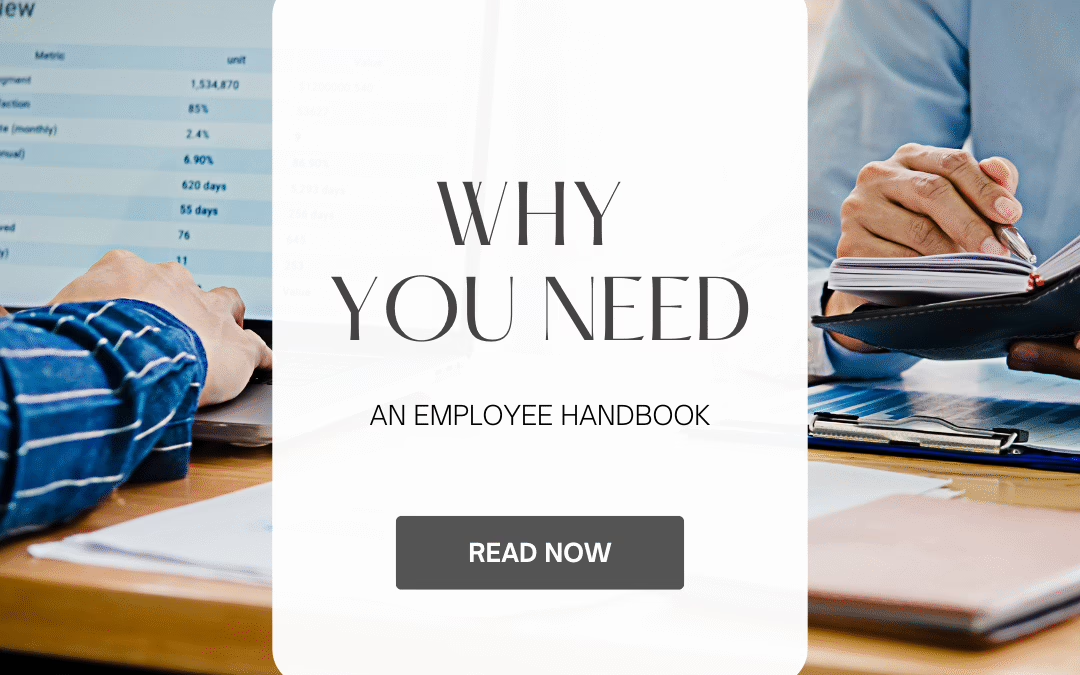If you have employees, you need an employee handbook.
It doesn’t matter if you have three team members or three thousand, having an up to date employee handbook can protect your business, align your team, and reduce your HR stress overnight.
While many small businesses skip it, thinking, “We’re not big enough for that,” that’s a costly mistake.
In this post, we’ll show you why a handbook is essential, what to include, what to leave out, and how to make one that fits your business.

Why Every Small Business Needs an Employee Handbook
An employee handbook does three critical things:
1. Protects the business legally: Clear policies reduce liability, especially in California highly regulated states. When resolving employee disputes, or navigating expectations, a well-written handbook is your businesses first line of defense.
2. Sets expectations: Speaking of expectations, a good handbook let’s employees know what’s allowed, what’s required, and how things are handled. From time off to discipline to dress code to reimbursement policies, an up to date handbook helps your employees know how to win at work.
3. Reinforces culture: A handbook helps define how the business operates and why. It tells the team, “Here’s how we do things around here.” When you don’t have a handbook:
-
Employees make assumptions
-
Managers treat people inconsistently
-
You scramble during conflicts or complaints
-
Legal risks increase, especially during terminations.
A good employee handbook brings clarity. A great one builds confidence.
What Your Employee Handbook Should Include
The best handbooks are short, specific, and regularly updated. Don’t overcomplicate it.
Here’s what every small business employee handbook should include:
1. Welcome & Company Overview
-
Brief intro from leadership
-
Your mission, vision, and core values
-
An statement that the handbook is not a contract
2. Employment Basics
-
At-will employment status (with correct legal language)
-
Equal opportunity and anti-harassment policies
-
ADA accommodation policies
-
Job classifications (full-time, part-time, exempt, non-exempt)
3. Workplace Expectations
-
Code of conduct
-
Attendance and punctuality
-
Dress code
-
Use of company equipment or vehicles
-
Communication policies (phone, email, social media)
4. Compensation & Time Off
-
Pay periods and methods
-
Overtime rules
-
PTO and sick leave policies
-
Holidays
-
Breaks and meal periods (state-specific requirements)
- Leaves of Absence
5. Performance & Discipline
-
How feedback and reviews work
-
Disciplinary process (e.g., verbal warning, written notice, termination)
-
Grievance or complaint reporting procedure
6. Legal Disclaimers
-
Handbook is not a contract
-
Policies may be changed at management’s discretion
-
Signature acknowledgment page
What NOT to Include in Your Employee Handbook
Just as important as what’s in your employee handbook is what you leave out.
Avoid:
-
Overpromising job security (“We never fire without cause”)
-
Complex legal language you copied from Google
-
State-specific rules from another state (especially if you operate in California)
-
Benefits details that change annually (instead, link to a separate summary plan document)
If you include outdated, unclear, or inconsistent policies, your handbook becomes a liability instead of a safeguard.
How Often Should You Update Your Handbook?
At minimum, review your employee handbook once a year. But if you’re growing, hiring, or expanding into new states, update it more often.
Changes in:
-
Employment laws
-
Company structure
-
Paid leave policies
-
Remote work expectations
…all mean it’s time to revise your handbook.
Need a Compliant, Customized Employee Handbook?
We help small businesses build employee handbooks that are legally sound, easy to understand, and tailored to your team.
With us, you’ll get:
-
Protection against risk
-
Clear systems for employees and managers
-
A handbook that evolves as you grow
Book a free consultation today and let us help you build or update your employee handbook the right way.
Contact Us
Have questions? Give us a call: 661-750-2183.
